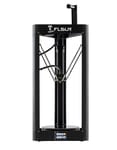According to Mahatma Gandhi, there was more to life than just increasing its speed. The same could be said for 3D printing.
Flsun might disagree with that, seeing as its new 3D printer is all about speed. It’s called the Super Racer, and the firm advertises it with lines like “make ideas come true in an instant”. Well, sadly, 3D printing takes a bit longer than an instant, but the Super Racer’s potential print speeds of up to 200 mm/s are undoubtedly eye-catching, and so is this machine’s design.
It’s a delta printer. And a fairly large one at that. With a build area of Ø260 x 330 mm, there’s lots of room to play with here, and there’s a lot of desirable features too. We’ve got linear rails, carbon fiber rods, a snazzy UI, and a detachable glass print bed all on the spec sheet. The price? $450.
With Flsun having some previous with delta 3D printers already in the form of the QQ-S Pro and the Q5, we’re eager to see how it gets on.
So, will the Super Racer qualify on pole position or slide off the track and beach itself in the gravel trap of mediocrity? Read on to find out.
Verdict
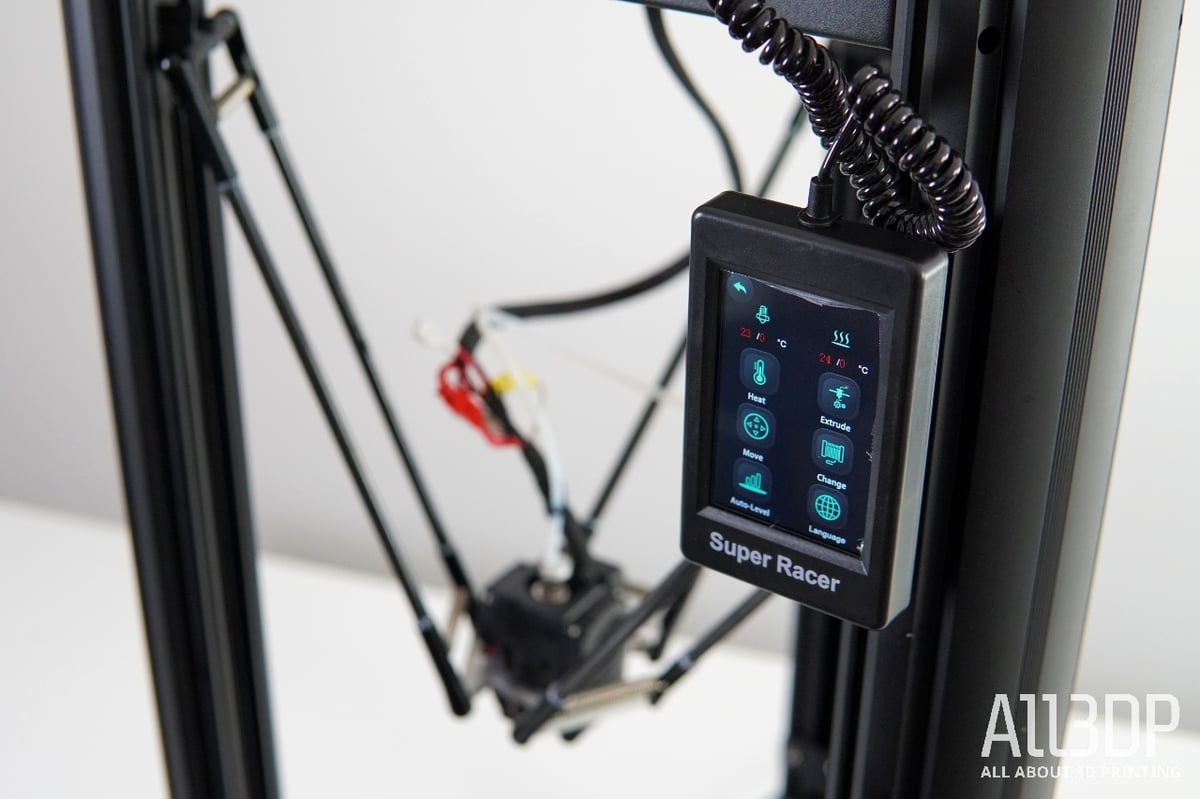
Pros
- Can print at an impressive pace
- Good print details possible at slower speeds
- Great build quality, components used.
Cons
- Glass bed isn’t the best
- Provided print profile didn’t work
- Much fine-tuning required to get good prints
The Flsun Super Racer is a fine delta 3D printer made from quality components. It feels strong, and as if it was built with real care by the manufacturer, with attention paid to the quality of components used and the execution of the UI. Plenty of printers don’t feel like that.
For us, it was a pretty frustrating time tweaking and adjusting things in order to achieve good prints, with bed adhesion a particular problem. That being said, plenty of users have attested to this machine being easy to work with right out of the box, so perhaps we just got a bit unlucky.
At $450, the Super Racer is a fair price for the handsome machine you get, but we can think of a few other FDM printers we’d rather spend that (or less) on for a better printing experience. As a delta 3D printer though, with the potential speed and “look-at-me” kinematics, this is probably the one we’d opt for right now. There’s definitely the potential in this machine for impressive results.

The Tech
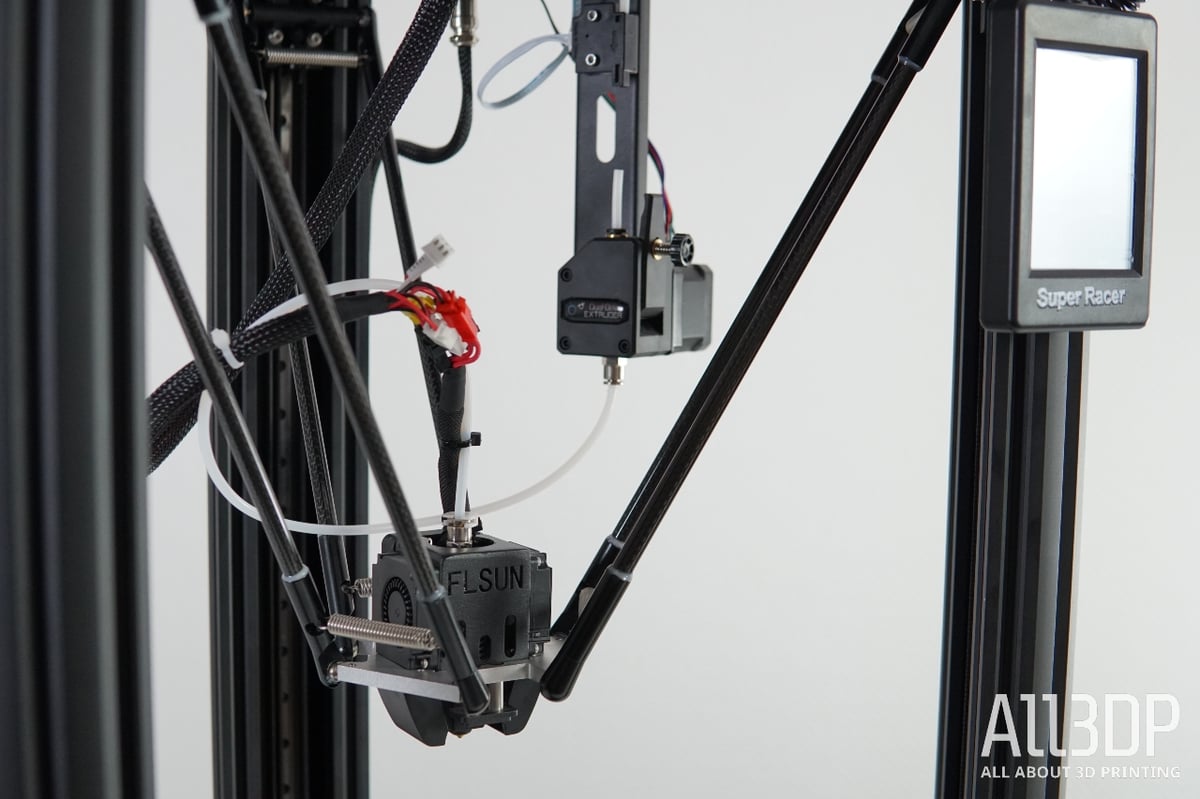
It’s not all that common to see a delta 3D printer arrive in the offices of All3DP, but here is the Flsun Super Racer. An undoubtedly cool-looking 3D printer.
A delta printer is quite different from the majority of budget FDM printers out there, the overwhelming majority of which are Cartesian coordinate robots – motion linearly moving in the X-, Y- and Z- axes. Delta printers are quite different to their Cartesian cousins, following the delta robot kinematics which uses a combination of three Z-axes simultaneously, linked by arms converging at a central point, in this case, the print head.
One upside is that such systems can be capable of some pretty impressive speeds, with the downside that they’re a bit finicky and can be a real pain in the proverbial to troubleshoot and repair. They’re sports cars, but in printer form, basically.
They’re pretty sporty looking too. On the Super Racer, the print head sits suspended above the removable textured glass bed, with carbon fiber connecting rods linking it to its 10 mm belts in the three pillars, with motion smoothly constrained along linear rails. Standing 960 mm tall, this isn’t a small machine and it might be tricky to accommodate its lofty stature on a shelf.
With a build volume of Ø260 x 330 mm, we have got a decent amount of space to be making prints here, though it’s worth noting that delta printers have a conical ceiling to their build volumes, as the print head can’t move horizontally at its upper reaches. It’s a delta design limitation kinda thing.
Cop Car UI
The Super Racer features a wee 3.5-inch touchscreen UI, which is attached to the printer via a spiral cable. Why? Because it’s brilliant, that’s why.
The screen attaches to the printer’s frame via a magnet, but you can take it off, stretch it up to your face and jab instructions on it before reattaching it to the magnet. Or just drop it in a stylish, sort of casual way and leave the room. It’s the sort of setup that reminds you of police cars of the 70’s and 80’s, and chasing the Blues Brothers. It’s the first 3D printer we’ve ever used to call for backup. (Still waiting on that, should you care.)
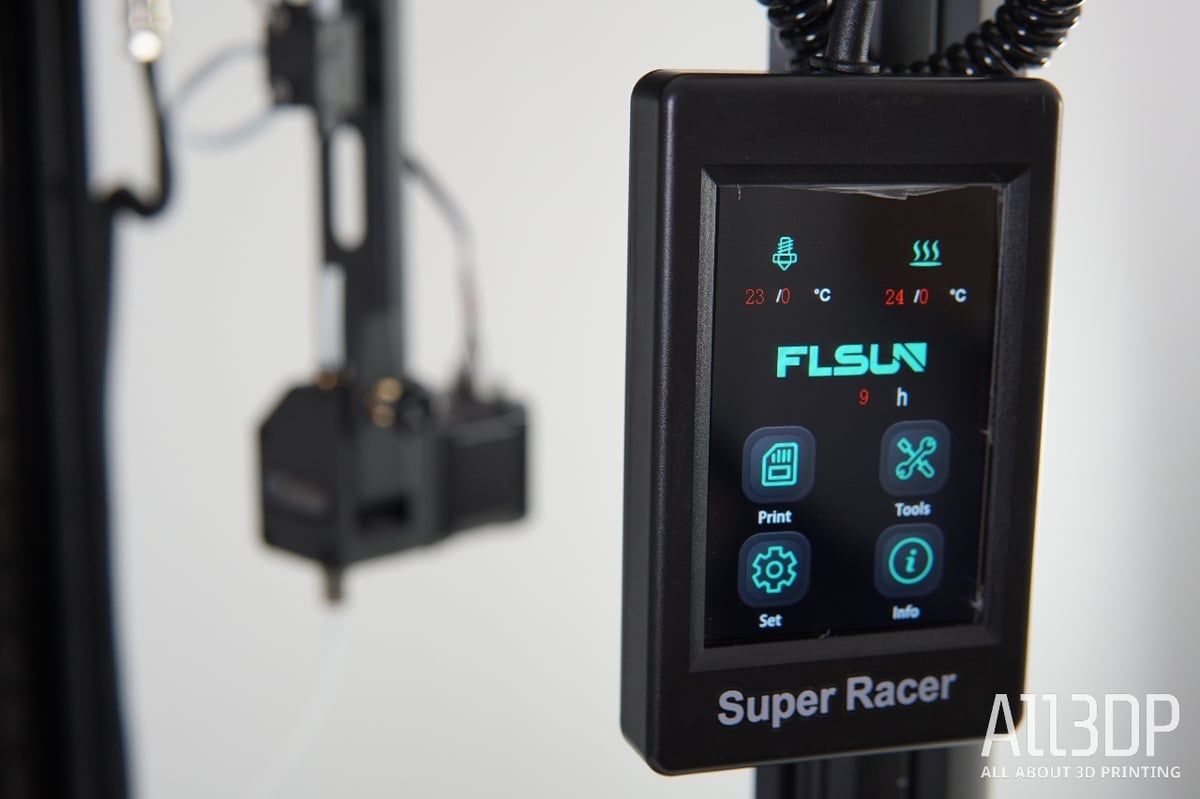
Despite its quirky design, the touchscreen itself is actually excellent. Very clear, very responsive, easy to navigate, and fun to work with. Bravo, Flsun.
As a matter of fact, the quality you feel in the touchscreen is very much indicative of the overall build quality of this machine. Everything feels very solid and well put together, it gives you the confidence of a well-built machine, and that’s not always the case with 3D printers, is it?
This leads us onto the extruder and the hot end. What we have with both of these components are copies of more famous, better-quality counterparts, namely E3D’s Titan geared extruder and V6 volcano hot end. The latter should help make sure there’s enough molten filament to keep pace with the Super Racer’s theoretical high speeds, though it only goes up to 240 ℃ so don’t expect to be printing anything exotic here.
We had no issues with extrusion during our spell with the Super Racer, everything was consistent and smooth and we particularly liked the unloading/loading filament option. The extruder just switches on one way or another and keeps going until you tell it to stop – no fuss.
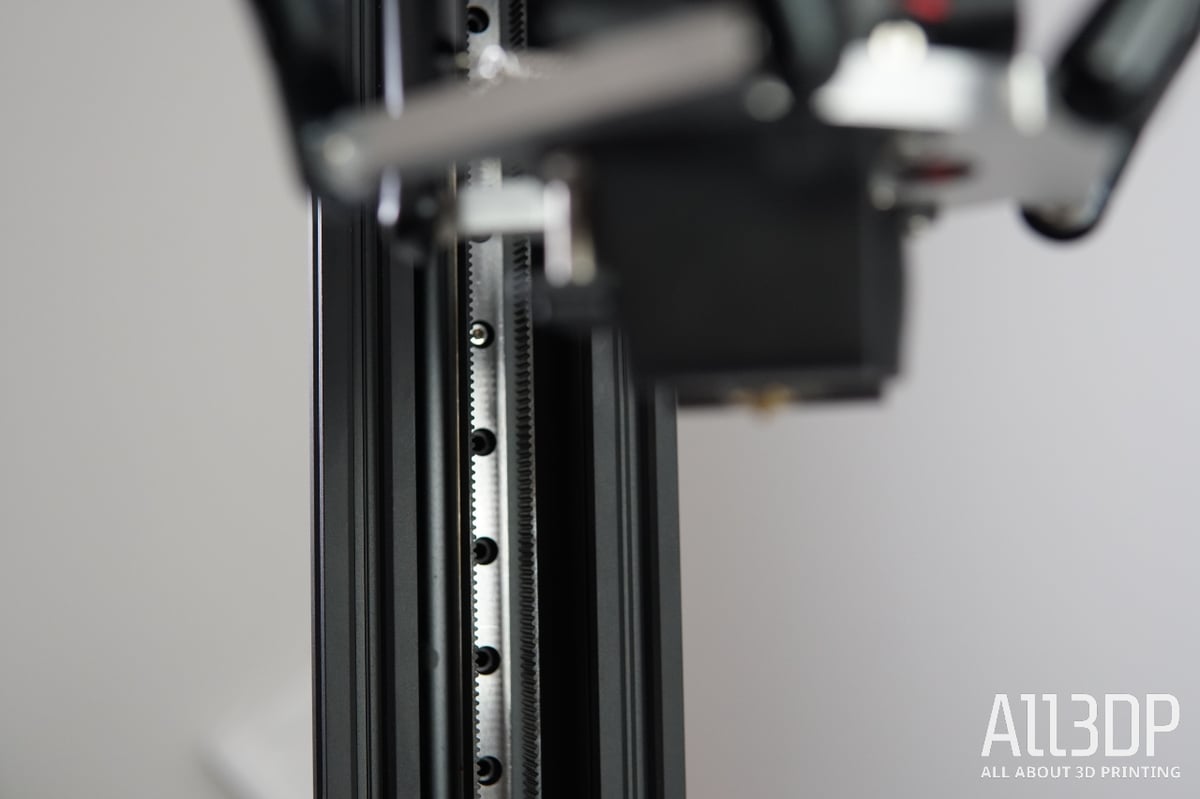
Handles Like It’s On Rails
We don’t often see linear rails on 3D printers, but they should offer better stability and smoother movements to the Super Racer. The stronger rails and the greater precision they offer should mean that everything is a bit more precise when it comes to printing, but we can’t claim to have seen a marked difference in the prints themselves.
Regardless of that, the rails themselves show that the overall quality of this machine goes deeper than just feel. Linear rails are a more expensive option than rods and bearings, so Flsun isn’t cutting any corners here. It’s built a solid machine with high-quality parts.
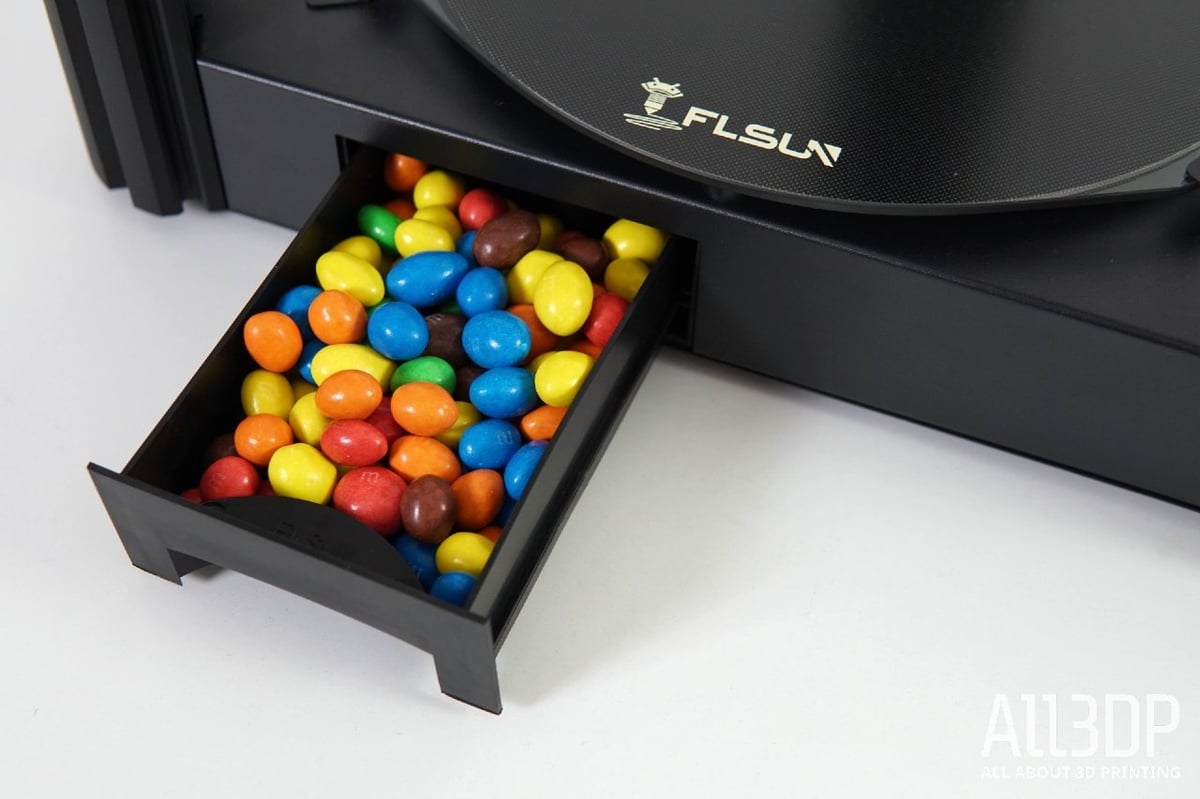
Automatic, Not Manual
Automatic bed leveling is always nice to have, isn’t it? The system on the Super Racer uses a probe you have to attach and reattach when necessary, but it’s perfectly simple. You plug it in and a magnet holds it in place over the end of the nozzle. A tap on the touchscreen or two later and it’s away automatically leveling against the glass print plate. Just remember to take it off before you start printing though.
The glass print plate itself is a disappointment. There’s little else we can say about it. Trying to get prints to stick well was a fairly frequent battle, which is frustrating when this type of textured glass bed on other printers grip prints without fuss. The lack of adhesion carried over to a consistent issue with warping in our prints. Bumping up the bed temperature and enlisting the help of Crew Chief Glue Stick didn’t help much. Printing with a brim helped the most. Something to chalk up to “more fine-tuning required.”

Printing and Usability
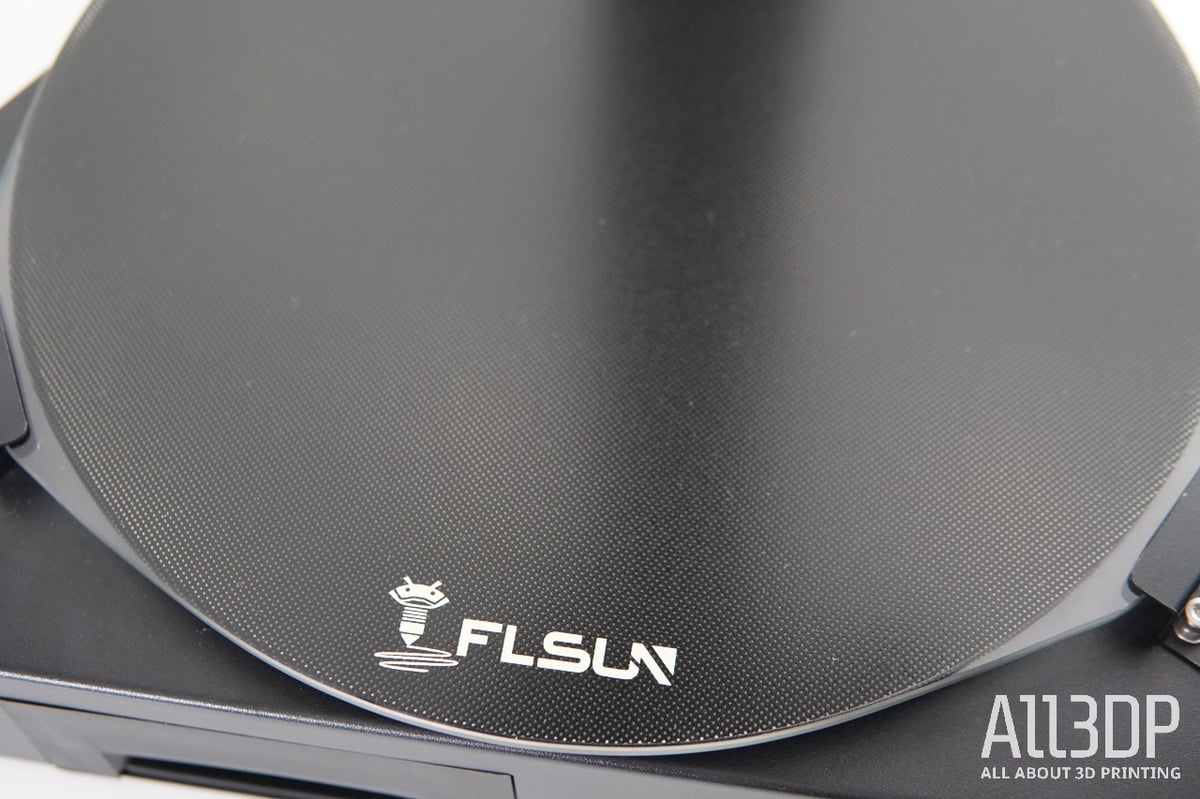
The assembly of the Super Racer takes no time at all. As with many budget 3D printer kits, the instructions are not good enough for complete beginners. They will suffice for anyone with a printer or two under their belt already.
The slicing software of choice here is likely to be Cura, and if you’ve the latest version of the software (4.10.0 at the time of writing) Flsun wants you to forget all about it. The provided printer profile comes bundled inside an old (4.4) version of Cura, which you’ll have to install if you want to extract it. We had a lot of issues getting what was provided to us on the USB stick to work, so we lobbed it in the bin and went with a modified version of the QQ-S profile on the most up-to-date version of Cura instead. No issues, simple to modify and, as it turns out, the USB stick wasn’t long for this world anyway. We can also point you towards this useful Reddit post that directed us to this link, where we could follow some basic instructions and install the Super Racer profile to Cura 4.10.
Setup caused no issues and test prints showed promising results, though we noticed that the cooling wasn’t as good as we would have hoped for, causing issues with bridging and overhangs in some more challenging testing. It’s not deal-breakingly bad, but it wasn’t as good as similar results from the sub-$200 Voxelab Aquila we tested recently.
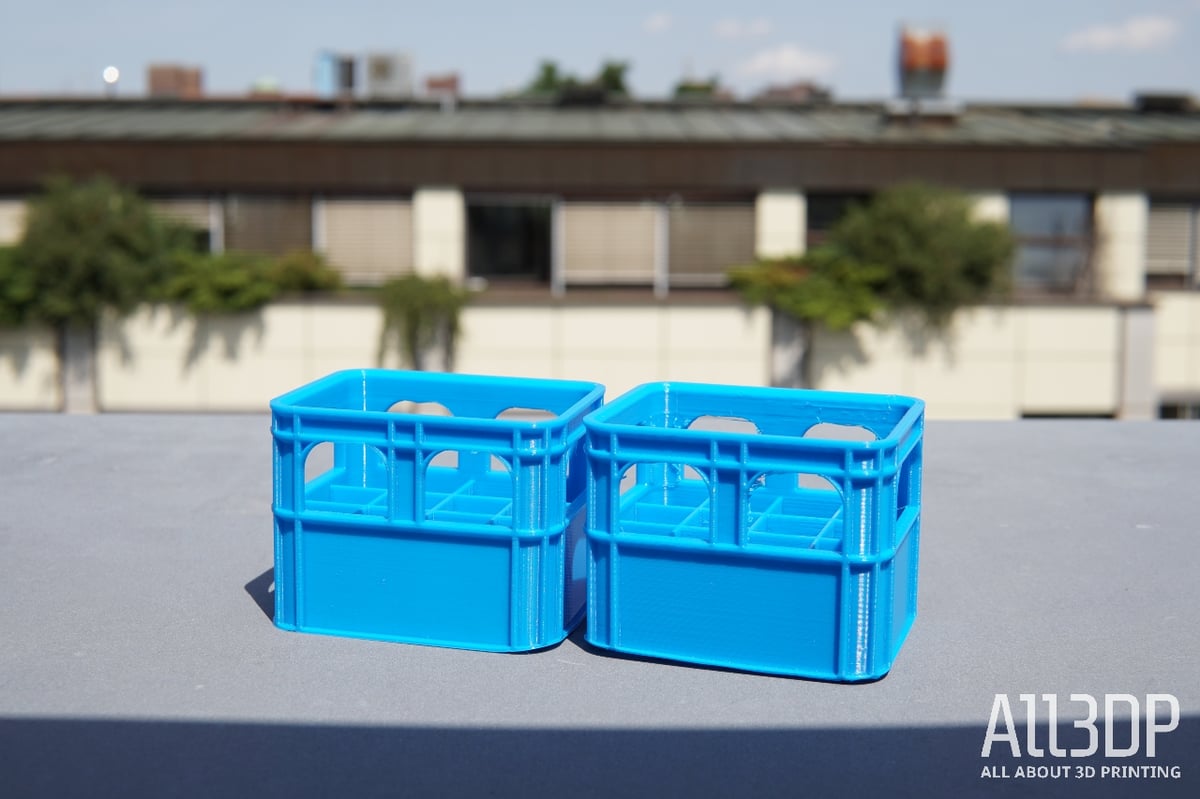
As mentioned above, bed adhesion proved to be a pretty tricky part of using this machine. The automatic leveling seems to have done its job just fine, but the printer initiated prints much higher than the print bed. Cue much jabbing of the Z-offset into the negative, and a sufficient level was found.
There seemed to be some inconsistency with how well filaments were sticking to the textured glass bed, and we used a variety of PLA, ABS and PETG during our time testing. Sometimes we’d get halfway through a print thinking we’d cracked the formula for getting something to stick, and it would come loose 3-4 hours into a print instead, leaving the nozzle to drag the unfinished print around like a toddler’s teddy.
Given our bed adhesion issues, it comes as no surprise that PETG was frustratingly difficult to dial in, and would peel off the bed whenever it had the chance. Multiple attempts to print with the material failed, we adjusted temperatures, checked the heights, added glue, removed the plate, cleaned it, re-leveled it and applied more glue – the lot. We only really had one successful PETG print with the machine.
Printing in PLA yielded some high-quality prints though; well defined with clean layers and few blemishes. Our battery beer crates in a hue of blue PLA inspired by the local breweries here in Munich exhibited some signs of warping, but in almost every other area they delivered. But here’s the thing, as expected, the best prints we produced were not fast prints.
Flsun is naturally very proud of the print speeds possible with the Super Racer, and yes, you can get prints done a bit quicker, but that comes at a cost – print quality. That’s a fairly substantial price to pay with 3D printing. We tried to demonstrate this by printing three Benchys at three speeds – 50, 100 and 150 mm/s.
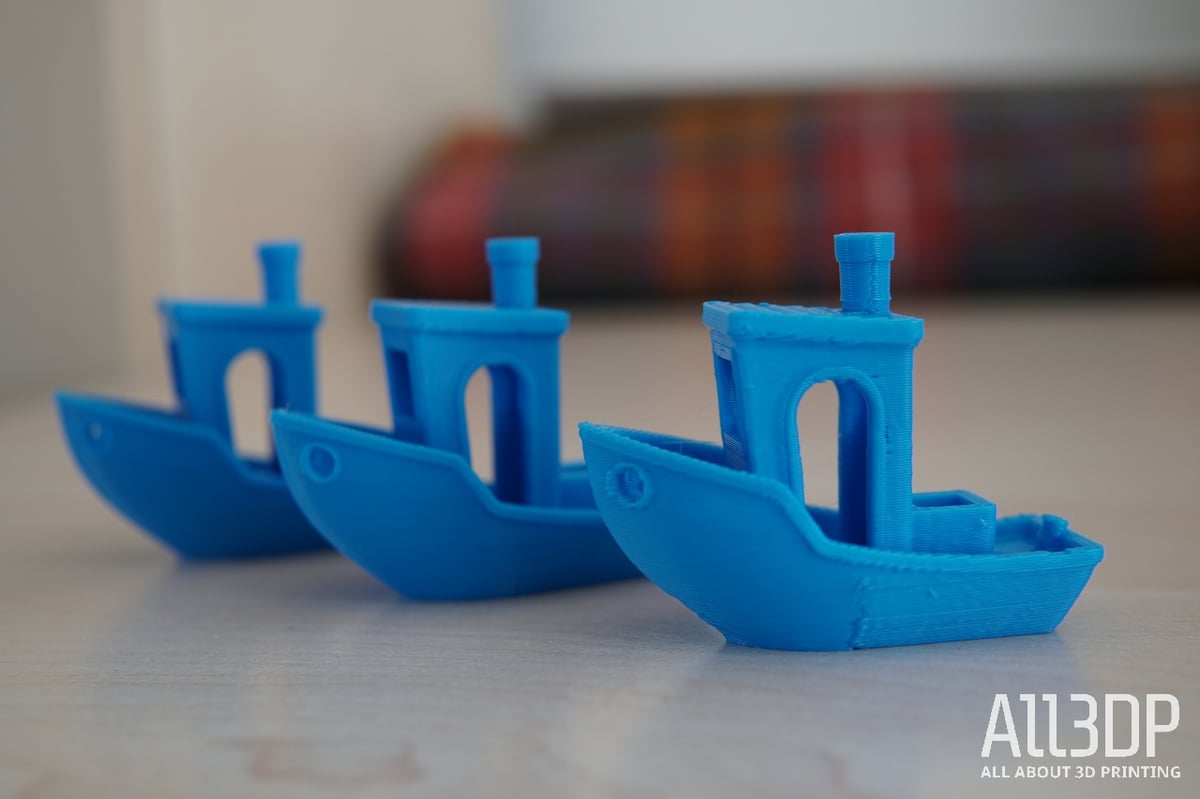
Between 50 and 100 mm/s, differences were not too pronounced, with the lower speed showing off a slightly better first layer, but with no striking imperfections in the rest of the body. 150 mm/s looks about as rough as you’d expect it to though. Taking 1 hr 11 mins, 47 and 29 mins respectively, there’s definitely time to be saved, but if your print isn’t as good it makes us wonder why you’d really want to. Flsun is keen to push the speed as the major aspect of this machine, but for us the major aspect is the quality of it. Speed isn’t everything, but it especially isn’t everything in 3D printing. Focus instead on the build quality and great components and UI, that’s what makes this printer impressive.
Somewhat frustratingly, we’ve seen accounts from users of this machine who said they’d had it running perfect prints right from the get-go, but our story is different. With the warping, bridging and bed adhesion frustrating us, a considerable amount of time was spent tweaking settings to get things the way we’d like them to be. A completed, good quality print was a rare occurrence.
We can’t deny that there’s a good 3D printer in the Super Racer. The evidence of this is in the crisp, detailed prints we’ve plucked from its round, disappointing bed. Its potential might take more extracting than you’d like. But, hey, it’s a 3D printer, and this is what happens sometimes. Given more time we’re confident we’d be experiencing consistent, fast, and beautiful prints, as intended.

Is It Worth It?
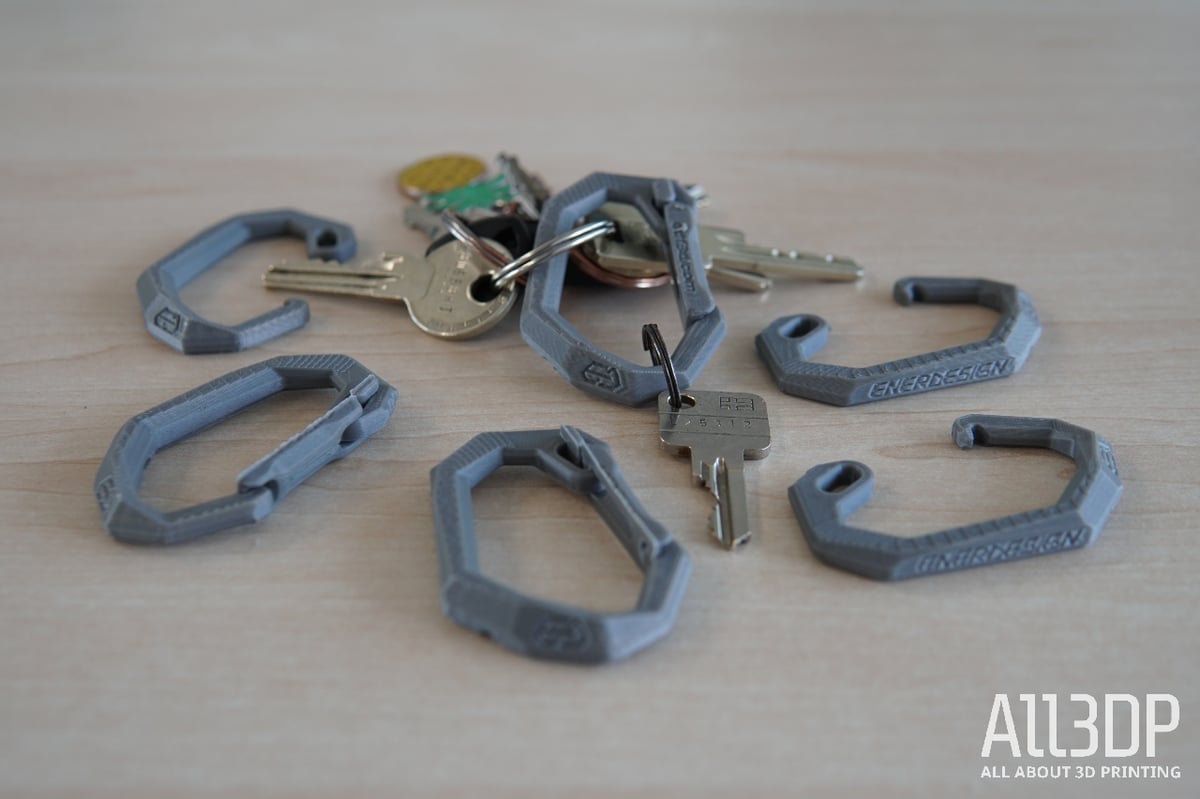
The Flsun Super Racer has the potential to go fast, yes, but in our experience thus far, is better off taking things slower to produce some really handsome-looking prints. Cooling isn’t as good as it could be, and the bed adhesion is a straight up pain.
There are, to our knowledge, no consistent complaints from others regarding the bed. We’d have preferred a removable magnetic bed, given the trickiness of undoing six screws every time you want to take the bed off the machine. It’s not particularly convenient.
We love the quirky, radio-like touchscreen and the overall build quality of this machine. It feels like it has been built with care and careful thought – plenty of 3D printers can’t claim the same. Being pragmatic though, at $450 we can think of better FDM 3D printers to spend our money on. But they’d have less character, and be less fun to use and watch in action.

Features
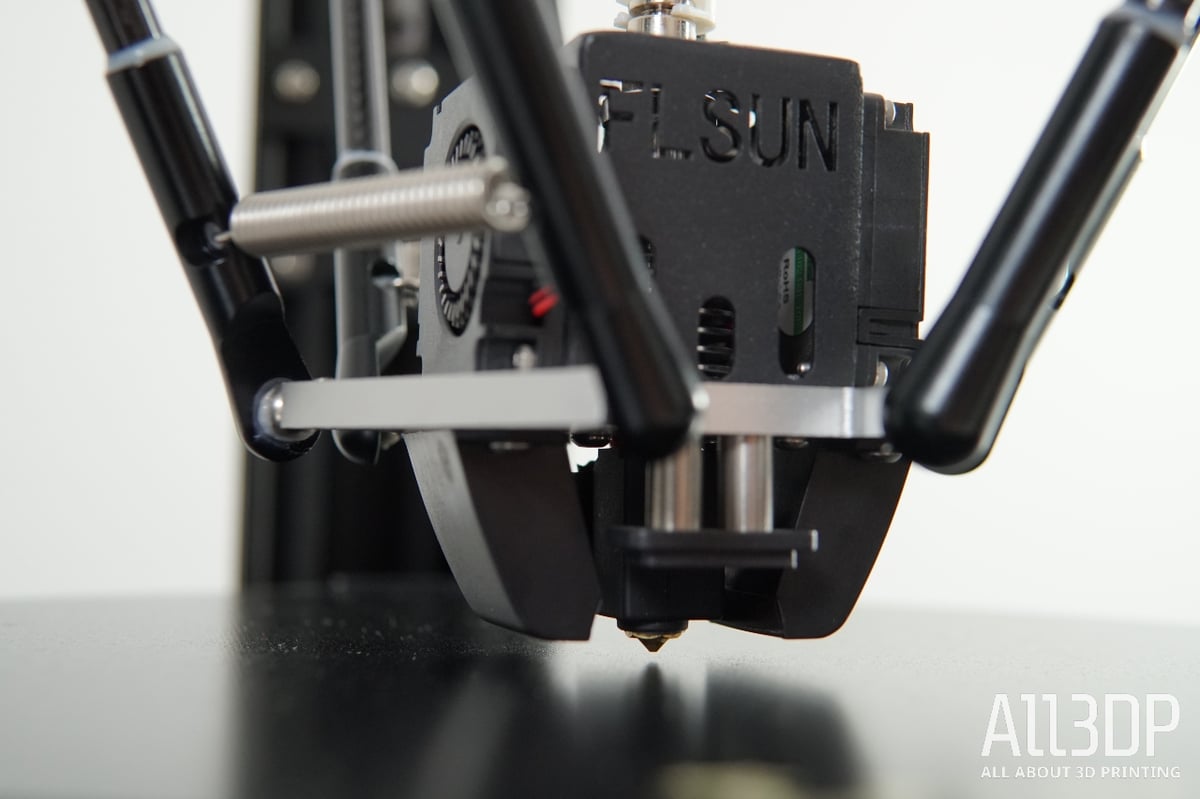
A delta with Bigness
The Flsun Super Racer is one of the bigger boys. Typically delta printers don’t house the largest build surface but can offer taller print heights. With Ø260 x 330 mm, it offers quite a sizable build volume, given its mechanical arrangement and price range. Delta printers are few and far between and with the print volume of the SR, typically found for twice the price.
At 960 mm in height, it’s taller than a jockey, and you need quite a bit of room to set it up, though. During its stint at the All3DP offices we had to keep it on the floor in a corner of our printer room.
Fast Print Potential
Flsun would be foolish to call a printer the “Super Racer” if it didn’t offer some impressive print pace. Flsun says the default printing speed of the SR is 150 mm/s, but it could go as fast as 200 mm/s if you wanted. For the sake of comparison, Flsun’s Q5 operates at 30-100 mm/s speeds. The default printing speed entirely depends on what you’ve asked the printer to do in your slicer though, and we saw in the review that 150 mm/s print speeds do not make for good prints.
In general, delta printers can print at higher speeds than your “typical” cartesian setup due to the mechanical arrangement and less moving mass. If you’re running this thing North of 100 mm/s, you’re going to see some side effects.
A 3.5-inch Dangly Touchscreen
The SR comes with a small touchscreen attachable to the frame of the printer via a magnet. You can take it off and move it around; it remains attached to the SR via one of those twisty stretchy cords you might have seen attached to the dashboard of a 1980’s police car.
At 3.5-inches, it’s not the biggest touchscreen out there, but the cord and the ability to move it around are great, especially when your printer is on the floor and you don’t want to bend over to make inputs. We love it.
Removable Glass Bed
The heated bed on the Flsun SR combines two noteworthy features: it is made of tempered glass, and it is removable, though you have to undo 6 screws around the bed to do so. The textured print surface should have proved good, but we struggled with bed adhesion during our time with the Super Racer.
When fixed in place, it can heat up to 100 °C, which is plenty enough for most filaments you’ll be using on a printer such as this. We’d advise keeping a glue stick around to help with adhesion though, especially when using PETG.
One other thing to mention about the bed is that it has automatic leveling. That’s nice, but the detachable probe needs to be removed and unplugged before printing again – just remember to do that or you’ll print onto the top of the sensor. We didn’t do that though. Nope.
Volcano Hot End
As the Flsun SR can reach high printing speeds, it is perhaps sensible that Flsun has chosen to outfit the machine with a volcano hot end. It should ensure that filament is melted quickly and efficiently and provide enough molten filament for the SR’s potentially high printing speeds.
A hot end like this also allows you to look into experimenting with different sizes of nozzles and flow rates too, so it gives an opportunity to makers to be more creative and explorative with their 3D printing hobby.
Dual-drive Extruder
The Flsun SR comes with a dual-drive Bowden extruder that should allow for a steady and reliable flow of filament to be fed into the hot end. Bowden-type extruders occasionally struggle with jam-free feeding of flexible filaments, but the dual drive should mitigate some of it as it provides an even feeding. Whether a 3D printer – Bowden or direct drive – has a good time with flexibles really comes down to experimenting and – potentially – a lot of slicer adjustments. So we wouldn’t rule it out just yet.
Carbon Fiber
Yes! No racer would be complete without a little carbon fiber garnish, and in the Flsun SR, it can be found in the parallel arms holding the print head. Carbon Fiber is a high-strength, ultra-lightweight material that should make the already lightweight print head even less heavy. With less mass to move around, operating at higher speeds becomes less prone to print artifacts.
It wasn’t all that long ago that this material was far too exotic (and expensive) to appear in a product costing this much.
Other Attractive Features
Two other features are briefly worth mentioning. The first is that this printer comes with a filament detector and print resume function, so if you’re forgetful when it comes to changing filament or live in an area with a slightly dodgy power supply, then it should have you covered. The other is that the SR’s stepper drivers are the “ultra-silent” TMC2209’s, and it does print pretty quietly. Not silently though, that would be silly.

Tech Specs
General Specifications
- Technology: Fused deposition modeling (FDM)
- Year: 2021
- Assembly: Partially assembled
- Mechanical arrangement: Delta
- Manufacturer: Flsun
3D Printer Properties
- Build volume: Ø260 x 330 mm
- Feeder system: Bowden
- Print head: Single nozzle
- Nozzle size: 0.4 mm
- Max. hot end temperature: 240 ℃
- Max. heated bed temperature: 100 ℃
- Print bed material: Glass
- Frame: N/A
- Bed leveling: Automatic
- Connectivity: USB, SD Card
- Print recovery: Yes
- Filament sensor: Yes
- Camera: No
Materials
- Filament diameter: 1.75 mm
- Third-party filament: Yes
- Filament materials: Consumer materials (PLA, ABS, PETG, Flexibles)
Software
- Recommended slicer: Cura, Repetier-Host
- Operating system: Windows, Mac OSX, Linux
- File types: STL, OBJ, AMF
Dimensions and Weight
- Frame dimensions: 440 x 390 x 960 mm
- Weight: 13.6 kg

Similar Printers
Delta printers are really cool to watch and often have an impressive turn of pace. If you’re into them, you might want to check out our Best Delta 3D Printers guide.
In the meantime, here are Flsun’s other delta 3D printers to compare to.
Flsun Q5
It’s older and smaller, but the Flsun Q5 is also cheaper than the new SR, meaning that it could save you a bit of cash if you don’t want or need the extra space and speed that the SR is offering here. Interestingly, both its hot end and its print bed can reach higher temperatures than the new Super Racer here.
Flsun QQ-S Pro
Flsun loves a delta 3D printer. Another one in the Flsun family is the QQ-S Pro, which is a little cheaper than the new SR here but has a slightly larger overall printing area. It can also reach higher temperatures than the SR in both its hot end and down on the print bed, but it can’t run at the high speeds the Super Racer offers.
License: The text of "Flsun (SR) Super Racer Review: The Fast and the Fidgety" by All3DP is licensed under a Creative Commons Attribution 4.0 International License.
CERTAIN CONTENT THAT APPEARS ON THIS SITE COMES FROM AMAZON. THIS CONTENT IS PROVIDED ‘AS IS’ AND IS SUBJECT TO CHANGE OR REMOVAL AT ANY TIME.







